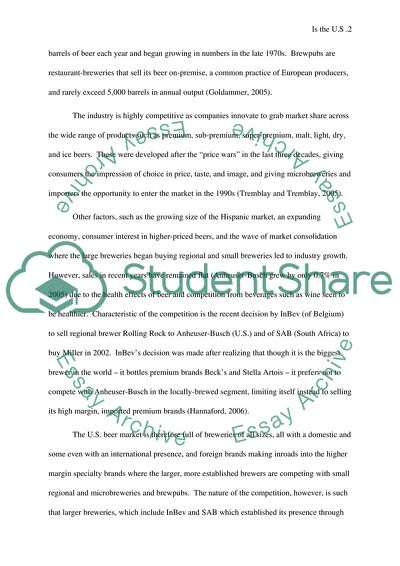
- Home
- Free Samples
- Premium Essays
- Editing Services
- Extra Tools
- Essay Writing Help
- About Us
- Studentshare
- Subjects
- Miscellaneous
- Oligopoly in the Beer Industry
Oligopoly in the Beer Industry - Essay Example

- Subject: Miscellaneous
- Type: Essay
- Level: Masters
- Pages: 4 (1000 words)
- Downloads: 0
- Author: greenholtleonor
Extract of sample "Oligopoly in the Beer Industry"
th innovations like marketing and light beer, setting the stage for a generation of microbrewers who reshaped the nature of the beverage we now think is as American as apple pie (Ogle, 2006). The U.S. beer industry is dominated by three major brewers: Anheuser-Busch, the makers of Budweiser and Michelob, SAB Miller, and Morson Coors. These three account for over 80% of total beer production and are large breweries with annual shipments of over 15 million barrels (31 gallons per barrel) nationwide and abroad.
Most of these breweries are located in Texas, Colorado, Wisconsin, and New York State (Tremblay and Tremblay, 2005). Regional breweries produce between 15,000 and 15 million barrels a year, with brews distributed in specific regions. Most regional breweries are privately held such as Pabst and Latrobe. Regional breweries account for approximately 15% of total U.S. beer shipments. Most of these breweries are located in Pennsylvania, Oregon, Wisconsin, and California (Goldammer, 2005). At the bottom of the industry pyramid are microbreweries and brewpubs, “craft brewers” that produce specialty niche products.
They ship less than 15,000 barrels of beer each year and began growing in numbers in the late 1970s. Brewpubs are restaurant-breweries that sell its beer on-premise, a common practice of European producers, and rarely exceed 5,000 barrels in annual output (Goldammer, 2005). The industry is highly competitive as companies innovate to grab market share across the wide range of products such as premium, sub-premium, super-premium, malt, light, dry, and ice beers. These were developed after the “price wars” in the last three decades, giving consumers the impression of choice in price, taste, and image, and giving microbreweries and importers the opportunity to enter the market in the 1990s (Tremblay and Tremblay, 2005).
Other factors, such as the growing size of the Hispanic market, an expanding economy, consumer interest in higher-priced
...Download file to see next pages Read MoreCHECK THESE SAMPLES OF Oligopoly in the Beer Industry
UK supermarket sector is an oligopoly
Monopoly, Oligopoly, Monopolistic competition, or Perfect competition
Competitive Oligology Industries
Wal-Mart and its Monopolistic Market
Why Do Oligopolists Engage in Little Price Competition but Extensive Product Development and Advertising
Oil and Gas Industry
The Impact of Oligopoly on the Media Industry
Changes in the Market for Groceries

- TERMS & CONDITIONS
- PRIVACY POLICY
- COOKIES POLICY